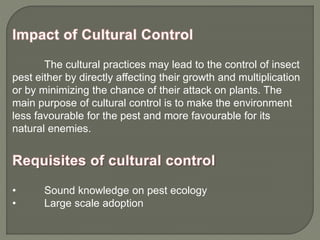Some Known Questions About Pestwise.
Some Known Questions About Pestwise.
Blog Article
8 Simple Techniques For Pestwise
Table of ContentsEverything about PestwiseGetting The Pestwise To WorkNot known Facts About PestwiseNot known Incorrect Statements About Pestwise Pestwise - TruthsThe Of PestwiseSome Of Pestwise

Q. Define "integrated parasite administration" (IPM) and listing several feasible control methods that may be made use of in an IPM strategy. A. Integrated insect administration is the integrating of appropriate insect control methods right into a solitary strategy to minimize insects and their damages to an acceptable degree. Parasite control tactics may consist of: host resistance, biological control, cultural control, mechanical control, sanitation, and chemical (chemical) control.
Pestwise Can Be Fun For Anyone
What can you do to maintain the insects you are trying to regulate from ending up being immune to the pesticides you make use of? A. Bug resistance can be lowered by utilizing integrated insect administration and revolving the kinds of pesticides utilized.
Insects are a critical threat to the farming organization, and integrated bug monitoring helps growers address and alleviate these risks. Integrated bug monitoring makes use of several methods in facility, therefore being a much more reliable option to the concern. Commercial Pest Control. Particularly, getting rid of hostile chemical approaches enables minimizing harm to people and the environment by utilizing all-natural and much safer choices instead
The Best Strategy To Use For Pestwise
The goal of incorporated insect management is to minimize this injury and control appropriate problem levels as opposed to get rid of all unwanted populations. This is why it is very important to recognize what procedures are justified in each instance and usage hostile ones only when various other integrated management techniques do not function. Integrated management minimizes the unfavorable effects of a non-IPM approach, and the major benefits of IPM Advantages of IPM.
An appropriate understanding of the infestation extent establishes if the issue should be attended to. are the next parts of an IPM program because it is essential to recognize if the organisms make possible risks and choose the integrated monitoring options or the details pesticide usage. plan to decrease problems by applying various agronomic techniques.
All About Pestwise
Integrated administration choices in an IPM program begin with much safer to much more hostile ones. The above-mentioned integrated monitoring aspects help understand how to plan and implement an IPM program step by action: Display your plants regularly.

Among others, IPM social techniques consist of the complying with area management techniques: dirt treatment; option of suitable plants; plant turning; interplanting or strip chopping; choice of growing days; weed control; use of trap plants. Positive soil problems speed up plant growth, and energetic plants are much more immune to invasions. Healthy plants and seeds determine successful crop growth, so it is important to pick pest-free planting product with solid roots.
Therefore, to name a few applications, plant rotation can be successfully used as an integrated bug management approach. Vermin spread slower if rows of different crop types separate their host plants in intercropping or strip chopping, which is additionally used in the integrated bug monitoring system. Conversely, invasions raise when plants of the very same crop type or family grow together.
Potato beetles can harm growing potatoes, in addition to tomatoes. Planting trap plants in patches is another choice for IPM intercropping. This integrated bug administration technique suggests drawing in insects to certain plants and afterwards managing them with chemical or mechanical methods. Specifically, you can grow soybeans as trap crops for Japanese beetles.
The Single Strategy To Use For Pestwise
Barriers are common instances of physical IPM techniques. Let's take a more detailed take a look at them. Getting rid of or choosing pests out by hand is a time and labor-consuming option that is extensively applied in incorporated administration and natural farming. Mature insects or their eggs and larvae are gathered by hand and find here destroyed.

Division of Plant Sciences. College of Missouri. Soil solarization is an efficient incorporated administration strategy to decontaminate the field by warming it in an all-natural way. This incorporated monitoring method indicates a typical way of ruining parasites by predators, parasitoids, microorganisms, and various other organic control agents (aka hostile microorganisms). The duty of biological control in IPM is to.
Pestwise Fundamentals Explained
With time, their population became a real problem to farmers alongside indigenous kangaroos or dingoes. The cane toad is another situation showing integrated biological control failure hereof when it rejected to quest the target species and became an insect itself. Parasitoids establish on or within their hosts to eventually kill them after growing.
Report this page